
Austria-Hungary, often referred to as the Austro-Hungarian Empire, the Dual Monarchy, or Austria, was a constitutional monarchy and great power in Central Europe between 1867 and 1918. It was formed with the Austro-Hungarian Compromise of 1867 in the aftermath of the Austro-Prussian War and was dissolved shortly after its defeat in the First World War.

Czechoslovakia was a landlocked country in Central Europe, created in 1918, when it declared its independence from Austria-Hungary. In 1938, after the Munich Agreement, the Sudetenland became part of Germany, while the country lost further territories to Hungary and Poland. Between 1939 and 1945, the state ceased to exist, as Slovakia proclaimed its independence and the remaining territories in the east became part of Hungary, while in the remainder of the Czech Lands, the German Protectorate of Bohemia and Moravia was proclaimed. In 1939, after the outbreak of World War II, former Czechoslovak President Edvard Beneš formed a government-in-exile and sought recognition from the Allies.
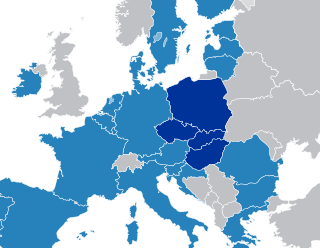
The Visegrád Group is a cultural and political alliance of four Central European countries: the Czech Republic, Hungary, Poland, and Slovakia. The alliance aims to advance co-operation in military, economic, cultural and energy affairs, and to further their integration with the EU. All four states are also members of the European Union (EU) and the North Atlantic Treaty Organization (NATO).

The national flag of Germany is a tricolour consisting of three equal horizontal bands displaying the national colours of Germany: black, red, and gold. The flag was first sighted in 1848 in the German Confederation. It was officially adopted as the national flag of the Weimar Republic from 1919 to 1933, and has been in use since its reintroduction in West Germany in 1949.

The Austro-Hungarian Compromise of 1867 established the dual monarchy of Austria-Hungary, which was a military and diplomatic alliance of two sovereign states. The Compromise only partially re-established the former pre-1848 sovereignty and status of the Kingdom of Hungary, being separate from, but no longer subject to, the Austrian Empire. The compromise put an end to the 18-year-long military dictatorship and absolutist rule over Hungary which Emperor Franz Joseph had instituted after the Hungarian Revolution of 1848. The territorial integrity of the Kingdom of Hungary was restored. The agreement also restored the old historic constitution of the Kingdom of Hungary.
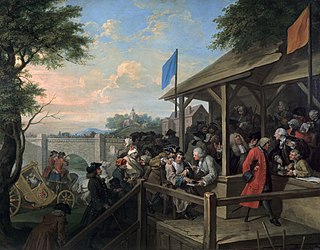
Political colours are colours used to represent a political ideology, movement or party, either officially or unofficially. They represent the intersection of colour symbolism and political symbolism. Politicians making public appearances will often identify themselves by wearing rosettes, flowers, ties or ribbons in the colour of their political party.

The United States of Greater Austria was an unrealized proposal made in 1906 to federalize Austria-Hungary to help resolve widespread ethnic and nationalist tensions. It was conceived by a group of scholars surrounding Archduke Franz Ferdinand of Austria, notably by the ethnic Romanian lawyer and politician Aurel Popovici.
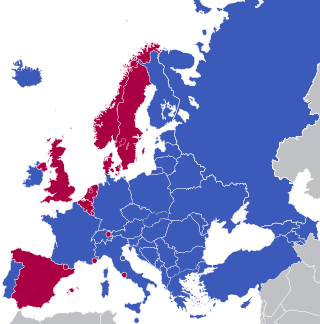
Monarchy was the prevalent form of government in the history of Europe throughout the Middle Ages, only occasionally competing with communalism, notably in the case of the Maritime republics and the Swiss Confederacy.

The Republic of German-Austria was an unrecognised state that was created following World War I as an initial rump state for areas with a predominantly German-speaking and ethnic German population within what had been the Austro-Hungarian Empire, with plans for eventual unification with Germany. The territories covered an area of 118,311 km2 (45,680 sq mi), with 10.4 million inhabitants.

The national colours of the Federal Republic of Germany are officially black, red, and gold, defined with the adoption of the West German flag as a tricolour with these colours in 1949. As Germany was divided into West Germany and East Germany beginning in 1949 and continuing through 1990, both Germanies retained the black, red, and gold colors on each respective flag. After German reunification in 1990, West and East Germany adopted the West German flag as the flag of the reunited Germany, therefore maintaining black, red, and gold as Germany's colors.

The Revolutions of 1848, known in some countries as the Springtime of the Peoples or the Springtime of Nations, were a series of political upheavals throughout Europe starting in 1848. It remains the most widespread revolutionary wave in European history to date.
CDU/CSU, unofficially the Union parties or the Union, is a centre-right Christian democratic political alliance of two political parties in Germany: the Christian Democratic Union of Germany (CDU) and the Christian Social Union in Bavaria (CSU).
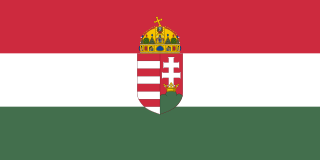
The Kingdom of Hungary, referred to retrospectively as the Regency and the Horthy era, existed as a country from 1920 to 1946 under the rule of Regent Miklós Horthy, who officially represented the Hungarian monarchy. In reality there was no king, and attempts by King Charles IV to return to the throne shortly before his death were prevented by Horthy.

The Reichsbanner Schwarz-Rot-Gold was an organization in Germany during the Weimar Republic, formed by members of the Social Democratic Party of Germany (SPD), the German Centre Party, and the (liberal) German Democratic Party in February 1924. Its goal was to defend parliamentary democracy against internal subversion and extremism from the left and right, to compel the population to respect the new Republic, to honor its flag and the constitution. Its name is derived from the Flag of Germany adopted in 1919, the colors of which were associated with the Weimar Republic and liberal German nationalism.
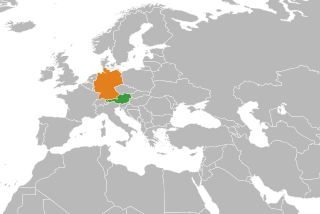
Relations between Austria and Germany are specially close due to their shared history, culture, and language; with Germans being the main ethnic group and German being the official language of both countries.

Bilateral relations exist & existed between Austria and Russia and their predecessor states. Since October 1955, the Republic of Austria maintains the constitutionally-mandated status of neutrality; the country is a founding member of the Organisation for Economic Co-operation and Development (OEEC). Austria joined the EU in 1995. Russia is a permanent member of the United Nations Security Council, a partner of ASEAN, a member of the Shanghai Cooperation Organisation (SCO), the G20, the Asia-Pacific Economic Cooperation (APEC), the Organization for Security and Co-operation in Europe (OSCE), as well as the leading member state of the Commonwealth of Independent States (CIS), the Collective Security Treaty Organization (CSTO), and the Eurasian Economic Union (EEU). Both countries are members of the Organization for Security and Co-operation in Europe and the World Trade Organization (WTO).
Monarchism is the advocacy of the system of monarchy or monarchical rule. A monarchist is an individual who supports this form of government independently of any specific monarch, whereas one who supports a particular monarch is a royalist. Conversely, the opposition to monarchical rule is referred to as republicanism.

Working Community of Cantons, Provinces, Counties, Regions and Republics of East Alpine Region or The Alps-Adriatic Working Group is an international organization that promotes co-operation between the states of the Eastern Alps and the Northern Adriatic region in the field of tourism, environmental protection, culture, science, politics, economy and European integration. The initiative to establish the group came from Italy and the body was founded in Venice in 1978. It initially served as a common forum for subnational units of Austria, Italy and Yugoslavia.


















